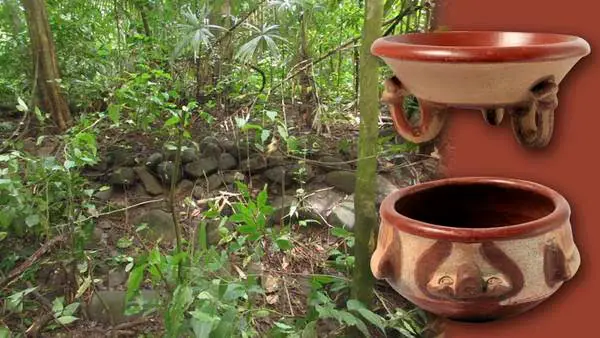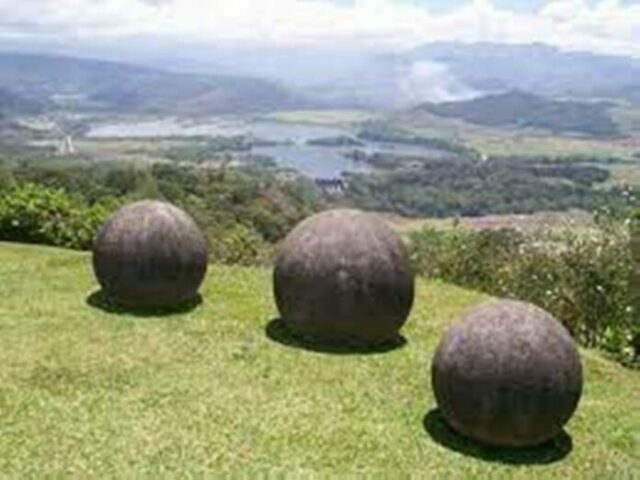A few days ago, it was learned that through laser mapping, studies and excavations, coordinated by the archaeologist Yahaira Núñez and the geologist Paulo Ruiz, from the University of Costa Rica (UCR), together with other researchers, a so-called indigenous town, emerged from the dense forest in Turrubares, within the Carara National Park.
It is worth noting that the authentic secrets of the archaeological site date between 800 and 1,500 AD. near the Tarcoles River in Costa Rica. Everything found in the Turrubares forest is of great scientific potential that reveals how our ancestors built, worked and lived among stone and straw habitats and ceramic vessels.

Similarly, the large number of metates or grinding stones discovered in the excavations suggest large-scale food processing, including maize. Certain tools, as well as botanical remains, indicate that cultivation work was also found.
We are talking about an architectural pattern and characteristics of the site called Lomas Entierros, which had been investigated in 1986 and which, according to new analyses, has a very different design from other archaeological sites in the country.
These are hills of more than five hectares, where a population flourished that forged a primary center in the Central Pacific subregion. The place is part of a system of hills that go from 14 to 380 meters above sea level; few archaeological excavations have been conducted there.
Currently, the forest that hides and protects Lomas Entierros can reach heights of between 30 and 40 meters with its laurel, mahogany, coral oak, cedar, botarrama and almond trees.
It was also known that those who were its inhabitants spoke Chibcha languages, adapted to the conditions of the natural topography and used the top of a hill, near the Tárcoles river, for defensive purposes and to supervise fluvial traffic.
The Tárcoles River was an important route of entry to the Central Valley. In many archaeological sites of the basin, exchange materials with Guanacaste and the Pacific of Nicaragua have been found, so it is possible that this was an important entry route for these objects.
It is not known how they disappeared, but the researchers comment that it could have been through conflicts with neighboring Chorotega populations, as reported by the Spanish chronicles.
About the process of laser image detection
The detection and range of laser images, better known as Lidar for its acronym in English, (Laser Imaging Detection and Ranging), was in a helicopter. It really was a scanner at its highest resolution that allowed mapping the distribution and characteristics of the buildings.
According to geologist Paulo Ruiz, the images collected were enough to determine and differentiate structures that were not formed by natural erosion and that, rather, corresponded to pre-Columbian structures.
The recent scientific exploration could be carried out thanks to scholarships from National Geographic, societies, foundations and universities, as well as the help of private companies and public institutions such as the National Museum and the National System of Conservation Areas (Sinac).
More indigenous wealth in Costa Rica
A short time ago, we spoke with the archaeologist of the National Museum, Ifigenia Quintanilla, who assures that the indigenous people have been the artists of the famous spheres.

According to investigations that have been carried out in the last 30 years, today it is known that in Costa Rica there are 4 archaeological sites with spheres included as part of the UNESCO World Heritage Sites, which is important since in America, there has been much denial of the indigenous contribution.

There is a rock that is in San Pedro de Pérez Zeledón, it is called the Coñanga stone and it owes its name to the former owner who was a renowned healer in the area. This rock, has the traces of the ancient glaciers of the upper part of the Cordillera de Talamanca and has figures engraved by indigenous hands from pre-Columbian times, it is a treasure of information on the geomorphology, climatic history and archeology of this area of Costa Delicious.
Also in the country it has been possible to appreciate the pre-Columbian rock in Bolsón de Santa Cruz de Guanacaste. In 2021, there were various discoveries and one very special one, a pre-Columbian stone sphere in perfect condition, that was found by workers of a farm located in the south of the country, to be specific Finca 12 in Palmar Sur de Osa, province of Puntarenas, the sphere measures approximately 1.23 meters in diameter.
Thanks to archaeologists and other specialists in the area, so many mysteries have been discovered and investigated, which are historical riches, treasures to always take into account.

